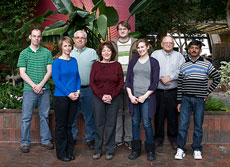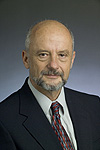|
Have a safe day!
Tuesday, Feb. 23
3:30 p.m.
DIRECTOR'S COFFEE BREAK - 2nd Flr X-Over
THERE WILL BE NO ACCELERATOR PHYSICS AND TECHNOLOGY
SEMINAR TODAY
Wednesday, Feb. 24
3:30 p.m.
DIRECTOR'S COFFEE BREAK - 2nd Flr X-Over
4 p.m.
Fermilab Colloquium - One West
Speaker: Joseph Polchinski, Kavli Institute for Theoretical Physics
Title: Gauge/Gravity Duality
Click here for NALCAL,
a weekly calendar with links to additional information.
Upcoming conferences |
|
For information about H1N1, visit Fermilab's flu information site.
|
|
Tuesday, Feb. 17
- Breakfast: bagel sandwich
- Chicken & rice soup
- Italian sausage w/ peppers & onions
- Beef stroganoff
- Lemon chicken
- Peppered beef
- Assorted sliced pizza
- Chicken tostadas
Wilson Hall Cafe Menu
|
|
Wednesday, Feb. 24
Lunch
- Wasabi- and panko-crusted pork loin w/ gingered soy sauce
- Jasmine rice
- Pea pods and carrots
- Cold lime soufflé
Thursday, Feb. 18
Dinner
Closed
Chez Leon Menu
Call x3524 to make your reservation. |
|
|
CD investigating outage, running at reduced power
On Wednesday morning, Feb. 17th, at 03:48 CST, a main breaker at the Feynman Computing Center tripped, causing power loss for many IT and scientific services for the Fermilab community and beyond to the Grid community. Throughout Wednesday and Thursday, Computing Division staff restored almost all IT services and most scientific computing services, after consultation with representatives of the service providers and experiments when that was possible.
This partial restoration of service is not a sustainable solution. The Computing Division and FESS are currently performing a root cause analysis of the breaker trip. Until this analysis is complete, and to lessen the risk of another trip, the facilities team has recommended operating the breaker at a reduced load consistent with our understanding of its ability to run without further trips. This means that we cannot now power up all services, and we may have to move some equipment to other CD computing rooms.
The Computing Division together with FESS are making an evaluation of the maximum power available and a plan for powering up all equipment as quickly as possible. If you have questions about the availability or priority of systems or services, please contact the Fermilab Service Desk, x2345 or http://servicedesk.fnal.gov. As the Computing Division gathers more information, we will continue to provide updates.
-- Vicky White, acting associate lab director for computing
|
New employees
 |
| New employees who began work on Feb. 15. Front row from left: Beth Dahl, Ruby Fanning, Elizabeth Wince, Prabhat Kumar Gupta. Second row from left: Nathan Duff, Steve Hentschel, Andy Jung, Ron Miksa |
|
Stealthy by air
 |
| Computing Division employee Gene Oleynik submitted this photo of a coyote in mid-pounce near Eola Road. |
|
Funding snag could shut down Sanford lab, backers say
From Rapid City Journal, Feb. 22, 2010
The Sanford Lab at Homestake could be forced to shut down this summer if a legislative dispute over state funding isn't resolved, lab officials said.
The South Dakota House of Representatives rejected a $5.4 million funding bill for the lab on Friday, but voted 68-2 on Monday to reconsider the funding measure. The measure, HB 1083, is scheduled for the floor today.
Backers say the $5.4 million sought by Gov. Mike Rounds is crucial to keeping the lab open until May 2011 when the National Science Board is to decide whether to approve a deep underground lab at the site. If the national lab is approved, the National Science Foundation would take over funding.
But without more money from the state, the lab project will run out of funds by December, according to Ron Wheeler, executive director of the South Dakota Science & Technology Authority Board, which is operating the project.
Wheeler said if the money is not approved, the Science & Technology Board would have to start shutdown plans before December.
"We would literally mothball the project," he said.
Read more
|
General relativity tested on a tabletop
From Nature News, Feb. 17, 2010
By measuring a spectacularly small difference in the ticks of two quantum clocks, physicists have proven a pillar of Albert Einstein's theory of gravity to be on firmer footing than ever before.
The experiment is the latest in a series of tests in which scientists have scrutinized one of Einstein's more profound predictions: that clocks in stronger gravitational fields run more slowly. For decades they have put clocks at higher elevations, where Earth's gravity is slightly weaker, and measured the ensuing changes. From a clock in a tower at Harvard University in Cambridge, Massachusetts, in the 1960s, to others flown on planes in the 1970s, to a clock that flew thousands of kilometres into space on a rocket in 1980, physicists have not been able to show that Einstein was wrong.
Read more
|
|
|
Yearly budget review
 |
Pier Oddone |
Once a year in February we make a very extensive budget presentation to the DOE Office of High Energy Physics. Last week seven senior managers of the laboratory traveled to DC for a full day of presentations to Dennis Kovar, DOE associate director for HEP, and the managers of the various programs in his office. The presentations, contained in 190 slides, followed a prescribed format and described how the laboratory would adjust to and perform under three budget scenarios from now through 2016. These yearly presentations provide essential information for OHEP in preparing and defending the budget for the 2012 fiscal year and beyond.
This year our situation is much clearer than it was either last year or the year before. In 2008, we had severe budget cuts that led to furloughs and a voluntary separation program; and we did not know whether we would secure the needed supplemental funding to restore our programs. In 2009, the Congress had a continuing resolution through March at the disastrous level of funding of FY2008, and we did not know where the budget would finally settle. By contrast this year we received our FY2010 budget early in the fiscal year and the proposed President's budget for FY2011 is pretty much steady as she goes, with a 2.3 percent increase for HEP.
Of the three budget scenarios OHEP asked us to analyze, we speculate that the middle scenario is the most likely prediction by OHEP for what lies ahead. This was a fairly restrictive scenario with only 2 percent growth per year through the next five years for the core programs of the laboratory. In this scenario the ramp-up of our two large projects, LBNE and Mu2e, balances the decrease in the Tevatron funding as the collider shuts down and as NOvA construction funding ends. Only in FY2015 and FY2016, the last two years under consideration, would Project X see a significant ramp-up.
The lowest budget scenario is, of course, worse and leads to reduced running of the complex in FY2012 and FY2013.
The scenario we like best is the high budget scenario, not constrained by funding. In this scenario we get to design an optimal program. Our analysis is not simply wishful thinking but provides the ammunition for OHEP to argue for more generous budgets in the years ahead based on the additional value we can deliver. This is especially important these days when the DOE priorities are so strongly aimed at energy and climate-change research. Such a budget would allow us to move forcefully in the three frontiers of our program, especially at the intensity frontier, and would attract the additional international partners that in the long term make a better, more exciting and more economical program.
|
|